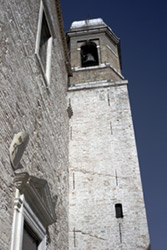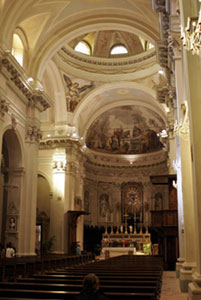 |
|
 |
|
|
Not only is the architecture of Cagli ancient
and historically significant, but the artwork is significant as
well. Frescoes — some of which are located in the cathedral
— date back to the 13th and 14th centuries during the Roman-Gothic
era. Renowned artist Maestro di Monte Martello painted the walls
of the sanctuary of Santa Maria delle Stelle. Cagliese churches
also contain the work of Giovanni Santi, father of the Renaissance
artist Raphael. "Thanks to the money given by the office
of the region, the paintings were restored to their natural richness,
and we are able to see and enjoy them,” said Papi. After the earthquake, frescoes by the late
Gothic painter Mello da Gubbio were discovered in the vault of the
church of San Francesco. Whitewashing had covered them in the 18th
century. The frescos contained nine lunettes and crowns of the 13th
century Gothic vault and portraits of the 12 apostles with angels
and prophets. Once the frescoes were discovered and recognized as the work of Mello da Gubbio, the office of the region was contacted, and money was granted to restore the paintings.
|
|
|
| The
duomo had also been damaged in an earthquake in 1781. The
dome near the main entrance was attached to the wall, and this collapsed
as a result of the first earthquake and remained unstable as a result.
During the 1781 earthquake, Bartolucci explained,
74 people were killed. They were buried underneath the church, and
every year the people of Cagli celebrate and honor those who died.
The town was extremely upset by the tragedy, but the ceremony of
remembrance continues to be a way they can come together to remember
what happened. After the 1997 earthquake, the dome again
separated from the wall, but it did not fall and there were no visible
signs of damage. "Before the earthquake hit, there was
shaking going on for about a year,” said Felici Giovanni,
a Cagli resident. “One night I thought the earthquake was
going to erupt so I slept in the car, but it ended up that nothing
even happened.” Cagli was lucky compared to other towns during
the most recent major earthquake. Assisi, about 53 kilometers from
Cagli, had the most impact. At least 10 people were killed, and
many buildings and pieces of artwork were damaged. The Basilica of St. Francis of Assisi is
located at the birthplace of St. Francis, making it an important
landmark for Christians. The first part of the earthquake appeared
at 2:35 a.m., and when the second part of it hit several hours later,
four people who were looking at the damage from the first shocks
were killed. Some pieces of art were also damaged including one
work associated with the school of Giotto. In Cagli, the duomo remained closed
for renovations for seven years, forcing long-time parishoners to
attend services at other churches. "I was very upset, but everyone thanked
God that everyone was okay,” said Bartolucci. On Palm Sunday 2004, the doors of the basilica
cathedral opened once again to greet the smiling faces of the Cagliese
people. "It was easy to see that Cagli had its church back again,” said Bartolucci. |
|
|
Story by Taylor Mikolasy Photos by Monica Hortobagyi Video by Cassie Robinson |
|




